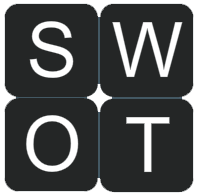SWOT
Developed in the 1960's as a planning tool for large businesses, SWOT analysis allows managers to consider key areas of the business and evaluate what is known against what might happen in the future. But it is equally valid and useful in a small business.
Strengths and Weaknesses represent what is known about the business; whilst
Opportunities and Threats represent what might happen in the future based on the Strengths and Weaknesses of the organisation.
Hover over the letters above for more information
Strengths
Positive business tangible and intangible attributes.
Whats are the main strengths of your business?
For example - its location, its unique product, great customer service, good staff etc.
Weaknesses
Positive business tangible and intangible attributes.
These are the weaknesses your business may have.
These can be the same as possible strengths as what are strengths to some are weaknesses to another
Opportunities
External attractive factors that give the business an opportunity to meet its objectives progress. What can you tap into? New products? New markets? Expansion? Merging? Change in economy etc?
Threats
External factors, often beyond the businesses control, which could represent a risk to its progress. What competitors do you have? What can you afford to do? Changes in politics, society, economy etc
-
Project
This resource was developed as part of an Erasmus+ project, funded with support from the European Commission under grant agreement 2016-1-SE01-KA203-22064.
The project was a collaboration between:
This resource has been released under Creative Commons license CC-BY-SA 4.0.
Contact
If you would like more information on this resource please contact:
- Academic content – The University of the Highlands and Islands (www.uhi.ac.uk)
- Technical resource development – The University of the Highlands and Islands Educational Development Unit - EDU (edu@uhi.ac.uk)
Disclaimer
Except where otherwise noted, this website is licensed under Creative Commons license CC-BY-SA 4.0. All images used under permission remain the copyright of the license holder.
PDF
Download a copy of this resource in PDF format.
You can also print individual pages by printing directly from the browser.
×






